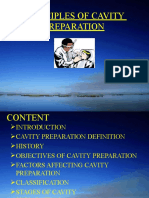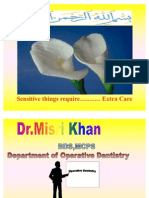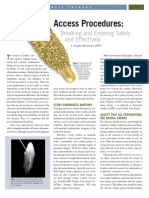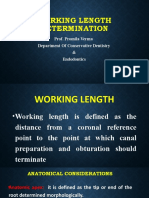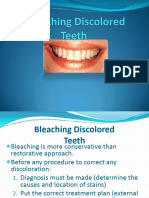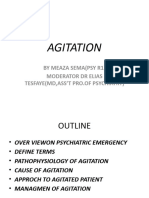0 ratings0% found this document useful (0 votes)
178 viewsEndo Access Cavity Preparation 5
Endo Access Cavity Preparation 5
Uploaded by
ahead1234This document summarizes dental anatomy, with a focus on pulp chamber and root canal morphology. It describes:
- The percentages of root canal locations in the apical, middle, and cervical thirds.
- Accessory foramina being present in all tooth groups, with maxillary premolars having the most and largest.
- Root canal configurations according to Vertucci, with the maxillary second premolar displaying all eight.
- C-shaped canals often occurring in mandibular second molars.
- Instruments used for access cavity preparation like round burs and explorer tips to locate canal orifices.
Copyright:
© All Rights Reserved
Available Formats
Download as PPT, PDF, TXT or read online from Scribd
Endo Access Cavity Preparation 5
Endo Access Cavity Preparation 5
Uploaded by
ahead12340 ratings0% found this document useful (0 votes)
178 views176 pagesThis document summarizes dental anatomy, with a focus on pulp chamber and root canal morphology. It describes:
- The percentages of root canal locations in the apical, middle, and cervical thirds.
- Accessory foramina being present in all tooth groups, with maxillary premolars having the most and largest.
- Root canal configurations according to Vertucci, with the maxillary second premolar displaying all eight.
- C-shaped canals often occurring in mandibular second molars.
- Instruments used for access cavity preparation like round burs and explorer tips to locate canal orifices.
Original Description:
Endo Access
Copyright
© © All Rights Reserved
Available Formats
PPT, PDF, TXT or read online from Scribd
Share this document
Did you find this document useful?
Is this content inappropriate?
This document summarizes dental anatomy, with a focus on pulp chamber and root canal morphology. It describes:
- The percentages of root canal locations in the apical, middle, and cervical thirds.
- Accessory foramina being present in all tooth groups, with maxillary premolars having the most and largest.
- Root canal configurations according to Vertucci, with the maxillary second premolar displaying all eight.
- C-shaped canals often occurring in mandibular second molars.
- Instruments used for access cavity preparation like round burs and explorer tips to locate canal orifices.
Copyright:
© All Rights Reserved
Available Formats
Download as PPT, PDF, TXT or read online from Scribd
Download as ppt, pdf, or txt
0 ratings0% found this document useful (0 votes)
178 views176 pagesEndo Access Cavity Preparation 5
Endo Access Cavity Preparation 5
Uploaded by
ahead1234This document summarizes dental anatomy, with a focus on pulp chamber and root canal morphology. It describes:
- The percentages of root canal locations in the apical, middle, and cervical thirds.
- Accessory foramina being present in all tooth groups, with maxillary premolars having the most and largest.
- Root canal configurations according to Vertucci, with the maxillary second premolar displaying all eight.
- C-shaped canals often occurring in mandibular second molars.
- Instruments used for access cavity preparation like round burs and explorer tips to locate canal orifices.
Copyright:
© All Rights Reserved
Available Formats
Download as PPT, PDF, TXT or read online from Scribd
Download as ppt, pdf, or txt
You are on page 1of 176
ANATOMY
74% - apical third
11% - middle third
15% - cervical third.
All groups of teeth had at least one accessory
foramen.
The maxillary premolars had the most and the largest
accessory foramina (mean value, 53 m) and the most
complicated apical morphologic makeup. The
mandibular premolars had strikingly similar
characteristics, a possible reason why root canal
therapy may fail in premolar teeth.
Anatomy of the Apical Root
The space between the
major and minor
diameters has been
described as funnel
shaped or hyperbolic, or
as having the shape of a
morning glory.
According to Weine
CANAL CONFIGURATIONS
According to Vertucci
The only tooth that showed all eight possible
configurations was the maxillary second premolar.
C-SHAPED CANAL
that often occurs in
MANDIBULAR SECOND MOLAR
C-shaped mandibular molars are so named because of
the cross-sectional morphology of their fused roots and
their root canals.
Instead of having several discrete orifices, the pulp
chamber of a molar with a C-shaped root canal system is
a single, ribbon-shaped orifice with an arc of 180
degrees or more.
Melton et al. in 1991 proposed the following classification of C-
shaped canals based on their cross-sectional shape. Fan et al. in
2004 modified Meltons method
Isthmus classifications described by Kim and colleagues.
Type I is an incomplete isthmus; it is a faint communication between two
canals.
Type II is characterized by two canals with a definite connection between them
(complete isthmus).
Type III is a very short, complete isthmus between two canals.
Type IV is a complete or incomplete isthmus between three or more canals.
Type V is marked by two or three canal openings without visible connections.
Nine guidelines, or laws, of pulp chamber
anatomy to help clinicians determine the
number and location of orifices on the
chamber floor:-
Law of centrality: The floor of the pulp chamber is
always located in the center of the tooth at the level of
the CEJ.
Law of concentricity: The walls of the pulp chamber are
always concentric to the external surface of the tooth at
the level of the CEJ, that is, the external root surface
anatomy reflects the internal pulp chamber anatomy.
Law of the CEJ: The distance from the external surface
of the clinical crown to the wall of the pulp chamber is
the same throughout the circumference of the tooth at
the level of the CEJ, making the CEJ is the most
consistent repeatable landmark for locating the position
of the pulp chamber.
First law of symmetry: Except for the maxillary molars,
canal orifices are equidistant from a line drawn in a
mesiodistal direction through the center of the pulp
chamber floor.
Second law of symmetry: Except for the maxillary molars,
canal orifices lie on a line perpendicular to a line drawn in
a mesiodistal direction across the center of the pulp
chamber floor.
Law of color change: The pulp chamber floor is always darker
in color than the walls.
First law of orifice location: The orifices of the root canals are
always located at the junction of the walls and the floor.
Second law of orifice location: The orifices of the root canals
are always located at the angles in the floorwall junction.
Third law of orifice location: The orifices of the root canals are
always located at the terminus of the roots developmental
fusion lines.
Allowing sodium hypochlorite
(NaOCl) to remain in the pulp
chamber may help locate a
calcified root canal orifice. Tiny
bubbles may appear in the
solution, indicating the position of
the orifice.
INSTRUMENTS USED IN
ACCESS CAVITY
Access burs: #2
and #4 round
diamond burs.
Access burs
Safety-tip tapered
diamond bur (left);
Safety-tip tapered
carbide bur (right
Access bur: round-end
cutting tapered diamond
bur
Access burs
A, Mueller bur
B, LN bur.
Gates-Glidden burs, 1 through 6.
Access instruments
DG-16 endodontic explorer (top);
JW-17 endodontic explorer (bottom).
It is the efficient uncovering the
roof of the pulp chamber &
providing the direct access to the
apical foramina by the way of
the pulp canals.
ACCESS OPENING
According to R.E. Walton, the 3 main objectives of access
cavity preparation are :-
1. Straight line access : Helps in
a. Improved instrument control.
b. Improved obturation.
c. Decreased procedural errors.
2. Conservation of tooth structure :-
a. Minimal weakening of tooth.
b. Prevention of perforation.
3. Un roofing of chamber and exposure of pulp
horns :-
a. Maximum visibility.
b. Location of canals.
Principles of Endodontic Cavity
Preparation
Endodontic Coronal Cavity Preparation :-
I. Outline Form
II. Convenience Form
III. Removal of the remaining carious dentin and
defective restorations.
IV. Toilet of the cavity
Principle I: Outline Form
The outline form of the endodontic cavity must be
correctly shaped and positioned.
Establish complete access for instrumentation, from
cavity margin to apical foramen.
External outline form = internal anatomy of pulp.
Principle II: Convenience form
(1) Unobstructed access to the canal orifice.
(2) Direct access to the apical foramen.
(3) Cavity expansion to accommodate filling
techniques.
(4) Complete authority over the enlarging
instrument.
Principle III: Removal of the Remaining Carious
Dentin and Defective Restorations
This according to Ingle, must be done for three reasons:-
(1) To eliminate mechanically as many bacteria as
possible from the interior of tooth
(2) To eliminate discoloration of tooth structure
(3) To eliminate the possibility of any bacteria- laden
saliva leaking into the prepared cavity.
Principle IV: Toilet of the Cavity
1. All of the caries, debris, and
necrotic material must be removed
before the radicular preparation is
begun.
2. 0bstruction, bacterial growth.
Pulp Canal Anatomy and Access Cavity Preparations
Endodontic Cavity Preparation Maxillary Anterior Teeth
Maxillary Central Incisor
Pulp chamber: -
Centrally located.
Broad mesio-distally.
Broadest incisally
3 pulp horns
Access opening:
Triangle in shape.
Maxillary Lateral incisor
Pulp chamber
Similar to central.
2 pulp horns
Access opening
Triangular /
ovoid
The root apex and the
apical foramen were
displaced distolingually.
Radicular developmental palatogingival groove.
A, Radiograph show lesion resulting from bacterial access along groove.
B, Extracted tooth shows extent of groove.
The incidence of radicular grooves is 3.0% in lateral incisors
Maxillary Canine
Pulp chamber
Largest among single
rooted teeth
Triangular
(labiolingually)
Flame shaped
(mesiodistally)
1 pulp horn
Access opening
Ovoid
Endodontic Cavity Preparation in Mandibular
Anterior Teeth
Mandibular Central and Lateral Incisors
Pulp chamber
Smallest in the arch.
Flat (mesiodistally)
Ovoid
(labiolingually)
3 pulp horns
Access opening
Long oval
(incisogingivally)
MANDIBULAR LATERAL INCISOR
A cross section of the root is
ovoid or hourglass in shape due
to the developmental
depressions on each side.
Mandibular Canine
Pulp chamber
More wide
(labiolingually)
Access opening
Ovoid
Anomalies
Rarely more than 1
canal and 1 root.
Endodontic Preparation of Maxillary
Premolar Teeth
Maxillary First Premolar
Pulp chamber
Narrow
(mesiodistally).
Wide
(buccolingually)
2 pulp horns (Buccal
& Palatal)
Root & root canal
2 roots (i.e. Buccal &
Palatal)
Access opening
Ovoid
(buccolingually).
The mesial root concavity is more prominent and
extends onto the cervical third of the crown.
This results in a root that is broad buccolingually and
narrow mesiodistally with a kidney shape when viewed in
cross section at the cementoenamel junction.
These anatomical features have implications in
restorative dentistry and in periodontal treatment, and
are common areas for endodontic root perforations.
Maxillary Second Premolar
Pulp chamber
Similar to 1
st
premolar
2 pulp horn.
Single canal orifice.
Root & root canal
Single rooted (90%)
Access opening
Ovoid (buccolingually)
The cross-sectional root
anatomy of the maxillary
second premolar in the
midroot area is described
as oval- or kidney-shaped
Endodontic Preparation of Mandibular
Premolar Teeth
Mandibular First Premolar
Pulp chamber
Prominent buccal pulp
horn.
30 lingual tilt of crown.
Root & root canal
Narrow (mesiodistally)
Broad (buccolingually)
Access opening
Ovoid
Upper 1/3
rd
lingual
incline of buccal cusp.
Mandibular Second Premolar
Pulp chamber
Prominent lingual
pulp horn.
Root & root canal
Wider (mesiodistally)
Broad
(buccolingually)
Access opening
Ovoid
Endodontic Preparation of Maxillary Molar Teeth
Maxillary First Molar
Pulp chamber
Largest in dental
arch.
4 pulp horns.
Roof: rhomboidal
Root & root canal
3 roots and 3 canals
Access opening
Rhomboidal
Of all the canals in the maxillary first molar, the MB2 can be the
most difficult to find and negotiate in a clinical situation.
The mesiobuccal root is broad buccolingually and has
prominent depressions or flutings on its mesial and distal
surfaces.
The internal canal morphology is highly variable, but the
majority of the mesiobuccal roots contain two canals.
The distobuccal root is generally rounded or ovoid in cross
section and usually contains a single canal.
The palatal root is more broad mesiodistally than
buccolingually and ovoidal in shape but normally contains only
a single canal. Although the palatal root generally appears
straight on radiographs, there is usually a buccal curvature in
the apical third.
Maxillary Second Molar
Pulp chamber
Similar to 1
st
molar.
Narrow
(mesiodistally)
Root & root canal
3 roots & 3 canals
Access opening
Similar to 1
st
molar
with variations as
anatomy dictates.
Endodontic Preparation of Mandibular Molar
Teeth
Mandibular First Molar
Pulp chamber
4 pulp horns.
Roof: rectangular
Floor: rhomboidal
Root & root canals
Usually 2 roots & 3
canals
Access opening
Trapezoidal or
rhomboid
Mandibular Second Molar
Pulp chamber
Same as 1
st
molar.
Root & root canals
Usually 2 roots & 3
canals
Access opening
Trapezoidal or
rhomboidal.
ERRORS IN CAVITY PREPARATION :
1. Perforations : caused due to failure to recognize
inclinations; depth of pulp chamber; assuming canal is
straight.
2. Gouging , overextension : caused due to failure to
recognize inclinations; unsuccessful search for canals or
receded pulp.
3. Under extension : Entire roof of pulp chamber not
removed, lingual shoulder not removed leading to curved
access.
4. Ledge : caused due to loss of instrument control.
5. Discoloration : incomplete removal of pulp debris.
6. Missed canals : due to small access cavity.
7. Broken Instruments : occurs in curved canals due to
failure in extending outline/internal prep.
QUESTIONS
1. Two pulp canals are usually found in
A. Mesial root of permanent mandibular first molar
B. Distal root of permanent mandibular first molar
C. Palatal root of permanent maxillary first molar
D. Distal root of permanent mandibular second molar
2. Shown below in the photograph dark lines between
two canal orifice is :-
A. Dentinal Groove
B. Dentinal Map
C. Formed because of faulty
access opening
D. Dentinal shadow
3. What % of lower 1
st
molars show 2 distal canals
A. 10%
B. 30%
C. 60%
D. 75%
4. Shown below tooth 43 is the case of :-
A. External root resorption
B. Internal root resorption
C. Lateral root perforation
D. Iatrogenic root perforation
5. What should be the treatment for the above case:-
A. Extraction
B. Repair of the resorption
C. Do a follow up for 6 months
D. No treatment is required
6. Shown below in the photograph is an example of:-
A. Furcation perforation
B. Pulp stone
C. Dental pulp
D. Both A & B
7. Two canals are most often seen in the:-
A. Maxillary canine
B. Mandibular canine
C. Maxillary lateral incisors
D. Mandibular first premolar
[Ref. Grossman 11
th
Ed Pg 166]
Bifurcations and trifurcations are most common in
mandibular 1st premolar.
They present a challenge during cleaning, shaping and
obturation. Because, of this it is known as "Enigma to
endodontist".
8. The fourth root canal if present in a maxillary 1st molar
is usually present in:
A. Mesiolingual root
B. Mesiobuccal
C. Palatal root
D. Distal root
9. Cervical cross section of maxillary first premolar has:
A. A round shape
B. Elliptical shape
C. Oval shape
D. Square shape
The mesial root concavity is more prominent
and extends onto the cervical third of the crown.
This results in a root that is broad buccolingually
and narrow mesiodistally with a kidney shape
when viewed in cross section at the
cementoenamel junction.
These anatomical features have implications in
restorative dentistry and in periodontal
treatment, and are common areas for
endodontic root perforations.
10. Shown below in the photograph is?
A. Endodontic explorer
B. Spoon excavator
C. Periodontal probe
D. Gingival marginal trimmer
11. Of the following permanent teeth, which is least
likely to have two roots?
A. Maxillary canine
B. Mandibular canine
C. Maxillary first premolar
D. Mandibular first premolar
CASE
Patient report to a clinic and
complains of pain while biting
in his lower anterior teeth. He
gave history of root canal
treatment 5 years back with
his lower anterior teeth.
12. What is the etiology for not healing of this lesion:-
A. Incomplete preparation & obturation
B. Missed canal
C. Lateral perforation
D. No reason
13. Accessory canals are most frequently found in:
A. The cervical one third of the root
B. The middle one third of the root
C. The apical one third of the root
D. With equal frequency in all the above mentioned
74% - apical third
11% - middle third
15% - cervical third.
14. There are sharp demarcations between pulpal
chambers and pulp canals in which of the following
teeth ?
A. Mandibular second premolars
B. Maxillary first premolars
C. Maxillary Lateral incisors
D. Mandibular canines
Ans. 'B' [Ref. Grossman 11
th
Ed Pg 156]
The division between root canal and pulp chamber is
indistinct in single rooted teeth whereas in posterior teeth
this demarcation is sharp.
15. In the mandibular arch, the greatest lingual
inclination of the crown from its root is seen in the
permanent:
A. Canine
B. Third molar
C. First premolar
D. Central incisor
Ans. C [Ref. Grossman 11
th
Ed Pg
167]
Mandibular 1st premolar contains
prominent buccal cusp and smaller
lingual cusp that give the crown a
lingual tilt of 30.
To compensate for the tilt and to
prevent perforations, the enamel is
penetrated at the upper 3rd of
lingual incline of facial cusp and
directed along long axis of root.
16. Shown below in the photograph is :-
A. Periodontal ligament
B. Iatrogenic perforation
C. Extruded gutta-percha
D. B & C
17. The mesiolingual root canal of the mandibular 1st
molar is found under the:
A. Mesio lingual cusp
B. Mesio buccal cusp
C. Central groove
D. Mesio lingual ridge.
Ans. C [Ref. Grossman 11
th
Ed Pg 170]
The mesiobuccal orifice is under the mesiobuccal cusp and is
usually difficult to find if enough tooth structure is not removed.
The mesiolingual orifice is present below the central groove.
The distal orifice has an elliptical shape and is usually present in
the centre of tooth buccolingually.
18. A divided pulp canal is most likely to occur in the:
A. Root of a maxillary canine
B. Root of mandibular canine
C. Root of a maxillary central incisor
D. Lingual root of a maxillary first molar
Ans. B]
19. If the pulp of the single rooted canal is triangular in
cross-section with the base of the triangle located
facially and apex located lingually with the mesial arm
longer than the distal, the tooth is most likely:
A. Maxillary central incisor
B. Maxillary lateral incisor
C. Mandibular second premolar
D. Mandibular central incisor
The occlusal cross-section view of maxillary central
incisor is triangular in shape; while the apex located
lingually and base of the triangle located facially.
Grossman/ll
th
ed/p-151
20. Considering the morphology of root and pulp canals, a
root canal instrument should be placed in what
direction to gain access to the Mesiofacial root of
permanent maxillary first molar:
A. From the mesiobuccal
B. From the distobuccal
C. From the mesiolingual
D. From the distolingual
Ans. D
In case of MAXILLARY FIRST MOLAR
The orifice of mesiobuccal canal is gained access from distopalatal
direction.
The distobuccal root canal is gained access from mesiolingual
direction.
The palatal root is gained access from buccal direction.
For MANDIBULAR 1
st
MOLAR:
The mesiobuccal orifice is present under mesiobuccal cusp and is
explored from mesiobucco apical direction.
The mesiolingual orifice is present below the central groove and is
explored from disto buccal direction.
The distal orifice is explored from a mesial direction.
21. Mandibular 1st molar has:
A. 2 roots and 2 canals
B. 2 roots and 3 canals
C. 3 roots and 3 canals
D. 3 roots and 4- canals
Ans. B [Ref. Grossman 11
th
Ed Pg 170]
22. In which single rooted tooth are bifurcated roots
present:
A. Mandibular lateral incisor
B. Maxillary canine
C. Mandibular central incisor
D. Mandibular premolar
23. Sown below is access opening of premolar. What iss
the error inaccess opening?
A. Outline form is incomplete
B. De-roofing is not done
C. Access cavity should be
mesio-distally wide
D. Both B and C
24. Which root canal is most difficult to prepare in
maxillary molar?
A. Mesiobuccal
B. Distobuccal
C. Palatal
D. Both A and B
Ans. A [Ref. Grossman 11
th
Ed Pg 161]
Mesio buccal root has greatest distal curvature and is
narrowest of all the three canals.
25. The most easily perforated tooth with a slight mesial
or distal angulation of bur after a mandibular central
incisor is:
A. Maxillary premolar
B. Maxillary molar
C. Mandibular premolar
D. Maxillary canine
The mesial root concavity is more prominent and
extends onto the cervical third of the crown.
These anatomical features have implications in
restorative dentistry and in periodontal treatment,
and are common areas for endodontic root
perforations.
26. A cross-section of the cervical third of the pulp canal
of a maxillary second premolar resembles in shape:
A. A circle
B. A square
C. A triangle
D. An ellipse.
The cross-sectional root
anatomy of the maxillary
second premolar in the
midroot area is described
as oval- or kidney-shaped
27. The root canals most likely to share a common apical
opening are:
A. Mesial and distal roots of mandibular premolars
B. Mesiobuccal and mesiolingual roots of mandibular first
molars
C. Both "A & B
D. None of above
Ans. C [Ref. Grossman 11
th
Ed Pg 167, 170]
The mesiobuccal and mesiolingual roots of mandibular
first molars are the root canals most likely to share a
common apical opening..
28. Branching of pulpal canals is least likely seen in:
A. Maxillary central incisor
B. Upper 1st premolar
C. Mand central incisor
D. Mand lateral incisor.
Ans. A [Ref. Grossman 11
th
Ed Pg 151]
29. The anterior tooth most likely to display two canals is:
A. Maxillary central
B. Maxillary lateral
C. Mandibular central
D. Mandibular lateral
30. The tooth which usually has the largest pulp chamber
in the mouth is the:
A. Maxillary central
B. Maxillary canine
C. Maxillary 1st molar
D. Mandibular 1st molar
Ans. C [Ref. Grossman 11
th
Ed Pg 160]
The pulp chamber of maxillary 1st molar is the
largest in the dental arch.
The pulp chamber of the maxillary canine
(Option 'B') is the largest of any single rooted
teeth.
31. Incidence of 3
rd
root in upper first premolar:
A. 6%
B. 10%
C. 12%
D. 1%
DIAGNOSIS
16. What is your diagnosis of this case?
A. Drug induced discoloration
B. Amelogenesis imperfecta
C. Non-vital tooth
D. Staining due to systemic disease
17. What should be treatment of choice for this
tooth?
A. Microabrasion
B. Night guard bleaching
C. Home applied technique
D. Walking bleach technique
BLEACHING
Themocatalytic or in-office
technique
(35% H2O2)
Nonvital Teeth
Walking bleach (Superoxol)
Power Bleach or in-office
technique
(35% H2O2 & Heat or light)
Vital teeth
Night Guard Bleach
(10-15% Carbamide peroxide)
18. What are the choice of agent in this bleaching
technique?
A. Superoxol + sodium perborate
B. Carbamide peroxide
C. 18% hydrochloric acid
D. Superoxol
Superoxol is heated directly within the pulp
chamber in the thermocatalytic bleach or mixed with
sodium perborate and sealed in the pulp chamber to
form the walking bleach.
19. What is the most important
complication that can occur due to
use of this agent?
A. Teeth become hypersensitive
B. External cervical resorption
C. Irritation of gingival papilla
D. Thinning of enamel
Studies found the incidence of cervical root
resorption after bleaching ranged from 0 to 6.9 percent.
it could occur in as many as one of every 12 teeth
bleached.
Therefore, it appears that the age of the patient at the
time the tooth became pulpless and the presence of a
barrier may be as important as the type of bleaching
agent and the use of heat during bleaching.
Upon successful bleaching of the tooth, rinse the
chamber and fill it to within 2 mm of the cavosurface
margin with a paste consisting of calcium hydroxide
powder in sterile saline.
Reseal the access opening with a temporary
restorative material in a manner previously described
and allow the calcium hydroxide material to remain
in the pulp chamber for 2 weeks.
20. What are the treatment modalities for repair of
resorption?
A. Extraction
B. Calcium hydroxide
C. Forced orthodontic extrusion
D. All of the above
There are treatment options for repair of resorption:-
1. Calcium hydroxide therapy.
2. Forced orthodontic extrusion.
3. Surgery.
4. Extraction.
Forced orthodontic extrusion
By extruding the root, the resorptive defect can be
elevated coronal to crestal bone.
Here it is accessible and can be included in a crown
preparation or repaired.
Specific orthodontic criteria must be met for success.
The crown/root ratio must be 1:1 and the root should
be non-tapering.
SURGERY
The most common approach to repair cervical defects is
surgery.
The resorption usually starts proximally and often wraps
around toward the palatal.
Both a labial and palatal flap are necessary for access.
The lesion is cleaned, bony contouring accomplished, and
the defect repaired.
Esthetic concerns may arise due to bone loss and tissue
changes. The tooth is more susceptible to fracturing.
Case 5
A 24 years old female patient complains of severe
throbbing pain from last few days with respect to lower
right back region.
Pain increases on lying down and is relieved with
analgesics.
Also pain is spontaneous in nature.
On oral examination, mandibular right first
permanent molar is found to be carious. The tooth is
sensitive to percussion.
21. What is diagnosis of this case?
A. Reversible pulpitis
B. Irreversible pulpitis
C. Symptomatic irreversible pulpitis
D. Hyperplastic pulpitis
Signs and Symptoms Pulpal Diagnosis Periapical
diagnosis
Sharp pain from exposed dentin on application of
thermal or osmotic stimuli. No dental abnormality.
Normal
( dentin
hypersensitivity)
Normal
Sharp pain from exposed dentin on application of
thermal or osmotic stimuli or both. Evidence of
dental caries, fractured restoration, cracked cusps
etc.
Reversible pulpitis Normal
Spontaneous, throbbing pain, sharp pain on
application of thermal stimuli that persists
following removal of stimulus.
Irreversible pulpitis Normal
Spontaneous, throbbing pain, sharp pain on
application of thermal stimuli that persists
following removal of stimulus.
Tender to bite or percussion or both. R/g widening
of PDL likely.
Irreversible pulpitis Acute apical
periodontitis
Spontaneous, throbbing pain. No response to
thermal stimuli. Tender to bite or percussion or
both. Localized or diffuse swelling may be there.
R/g may be inconclusive or lesion
Necrosis Acute
periradicular
abscess
22. Identify the area marked by circle X on radiograph?
A. Pulp stone
B. Radiolucency due to carious involvement of tooth
C. Nomal pulp canal
D. Normal pulp chamber
Increase the difficulty of negotiating the root canals.
The incidence of calcifications in the chamber or in the
canal may increase with periodontal disease, extensive
restorations, or aging.
23. What should be treatment in rendered in this
case?
A. Restoration with amalgam
B. Endodontic therapy
C. Direct pulp capping
D. indirect pulp capping
Direct pulp capping
Indirect pulp capping
24. A tooth tested nonvital in vitality tests showing
periapical radiolucency shows the presence of
a sinus tract clinically. What should be the
treatment for the sinus tract?
A no treatment
B curettage of the sinus tract
C Cauterization
D Irrigation with sodium hypochlorite
To trace the sinus tract, a size #25 gutta-percha cone is
threaded into the opening of the sinus tract.
25. In root fracture of the apical one - third of permanent
anterior teeth, the teeth usually:
A. Discolor rapidly
B. Remain in function and are vital
C. Undergo pulpal necroses and become ankylosed
D. Are indicated for extraction and prosthetic replacement
Apical 3
rd
Fracture
Fracture with no mobility no displacement of the coronal
segment and no symptoms- do not require any immediate
treatment.
Long term observation with periodic evaluation of pulp status.
If Considerable mobility- only splinting and periodic evaluation.
Healing is uneventful
Middle 3
rd
fractures
Most common site of occurrence.
Presents with considerable amount of mobility and
/or dislocation of the coronal segment.
The treatment is aimed towards preserving the
vitality and favor repair of the fracture.
Correct repositioning ( Reduction)
Splinting (Retention)
Coronal 3
rd
fractures
If reattachment of the fractured segments is
not possible the coronal segment must be
extracted and the choice of whether to retain
the apical fragment becomes major
predicament.
THANK YOU
You might also like
- NLN Medication Exam Study Guide QuizletDocument36 pagesNLN Medication Exam Study Guide Quizletmaniz442No ratings yet
- Mbacc Ebook Full PagesDocument115 pagesMbacc Ebook Full Pagesclaire m cook100% (4)
- A Cess Cavity PreparationDocument54 pagesA Cess Cavity Preparationmandy0077No ratings yet
- Endo4 Lec..6 Cleaning and Shaping of Root CanalDocument24 pagesEndo4 Lec..6 Cleaning and Shaping of Root Canalنور كاضمNo ratings yet
- Dr. Muneera GhaithanDocument44 pagesDr. Muneera GhaithanAli MezaalNo ratings yet
- Intra Canal MedicamentsDocument14 pagesIntra Canal MedicamentsS Noshin ShimiNo ratings yet
- Post and CoreDocument31 pagesPost and CoreSuraj ShahNo ratings yet
- 07 Endodontic RetreatmentDocument64 pages07 Endodontic RetreatmentGayathriNo ratings yet
- Slide - 11 - Procedural AccidentsDocument31 pagesSlide - 11 - Procedural AccidentsCWT2010100% (1)
- Root Canal ObturationDocument11 pagesRoot Canal Obturationrbm8dwmkb4No ratings yet
- Principles of Cavity PreparationDocument99 pagesPrinciples of Cavity PreparationAME DENTAL COLLEGE RAICHUR, KARNATAKANo ratings yet
- Apexification With MTADocument9 pagesApexification With MTAIngrid PatriciaNo ratings yet
- Irrigation of Root Canal: Assembled by Dr. Osama Asadi, B.D.SDocument35 pagesIrrigation of Root Canal: Assembled by Dr. Osama Asadi, B.D.SVizi AdrianNo ratings yet
- Intracanal MedicamentsDocument155 pagesIntracanal Medicamentssrishti jaiswalNo ratings yet
- Diagnosis & Case Selection in EndodonticsDocument54 pagesDiagnosis & Case Selection in EndodonticsRawzh Salih MuhammadNo ratings yet
- Anatomy of The Pulp SpaceDocument35 pagesAnatomy of The Pulp SpaceDeen MohdNo ratings yet
- Access Cavity Preparation FinalDocument63 pagesAccess Cavity Preparation Finalrasagna reddyNo ratings yet
- Curved and Calcified CanslsDocument25 pagesCurved and Calcified CanslsAiana Singh100% (1)
- Role of Antibiotics in EndodonticsDocument45 pagesRole of Antibiotics in EndodonticsAshutosh KumarNo ratings yet
- Irrigation and Intracanal Medicaments - Lecture 2 - LDocument49 pagesIrrigation and Intracanal Medicaments - Lecture 2 - Lshobhana20100% (1)
- Dental HipersensitivityDocument28 pagesDental HipersensitivitySergio KancyperNo ratings yet
- Chapter 7 Tooth Morphology and Access Cavity PreparationDocument232 pagesChapter 7 Tooth Morphology and Access Cavity Preparationusmanhameed8467% (3)
- Diagnosis in EndodonticsDocument16 pagesDiagnosis in Endodonticsمحمد صلاحNo ratings yet
- Zirconia Crowns in PedoDocument8 pagesZirconia Crowns in PedozaheerbdsNo ratings yet
- CMPDocument122 pagesCMPAnisha Anil100% (1)
- Operative Dentistry Lecture 1Document55 pagesOperative Dentistry Lecture 1Mohsin HabibNo ratings yet
- Endodontic Rotary InstrumentDocument4 pagesEndodontic Rotary InstrumentVinceNo ratings yet
- Principles of Cavity PreparationDocument14 pagesPrinciples of Cavity PreparationRockson Samuel100% (1)
- Recent Advances in Irrigation Systems PDFDocument6 pagesRecent Advances in Irrigation Systems PDFdrvivek reddyNo ratings yet
- Prepared By: Hashim M. Hussein M.Sc. of Conservative DentistryDocument61 pagesPrepared By: Hashim M. Hussein M.Sc. of Conservative DentistryPuteri NazirahNo ratings yet
- EMI. Khademi, ClarkDocument11 pagesEMI. Khademi, ClarkMaGe IsTeNo ratings yet
- Endo Lec 6 With AudioDocument44 pagesEndo Lec 6 With AudioمحمدNo ratings yet
- 5 - Procedural AccidentsDocument12 pages5 - Procedural AccidentsPrince AhmedNo ratings yet
- Microbiology Aspect in EndodonticsDocument80 pagesMicrobiology Aspect in Endodonticswhussien7376100% (1)
- Access ProceduresDocument4 pagesAccess ProceduresMonica Ioana Teodorescu100% (1)
- Working Length Determination: Prof. Promila Verma Department of Conservative Dentistry & EndodonticsDocument43 pagesWorking Length Determination: Prof. Promila Verma Department of Conservative Dentistry & EndodonticszaheerbdsNo ratings yet
- Enamel Remineralization A Novel Approach To Treat Incipient CariesDocument5 pagesEnamel Remineralization A Novel Approach To Treat Incipient CariesInternational Journal of Innovative Science and Research TechnologyNo ratings yet
- Antibiotics in Endodontics-Lecture 9Document49 pagesAntibiotics in Endodontics-Lecture 9mirfanulhaqNo ratings yet
- Radiology in EndodonticsDocument26 pagesRadiology in EndodonticsKifamulusi ErisaNo ratings yet
- DFG - Total ClassDocument37 pagesDFG - Total ClassSiva RamNo ratings yet
- BleachingDocument62 pagesBleachingوردة صبرNo ratings yet
- Khayat - Human Saliva Penetration of Coronally Unsealed Obturated Root Canals-Journal of EndodonticsDocument4 pagesKhayat - Human Saliva Penetration of Coronally Unsealed Obturated Root Canals-Journal of Endodonticsadioos6767No ratings yet
- Devitalizing Agents, Non-Vital Methods of Root Canal Therapy, Non-Vital Pulpotomy and Pulpectomy, Indications, Description of TechniquesDocument45 pagesDevitalizing Agents, Non-Vital Methods of Root Canal Therapy, Non-Vital Pulpotomy and Pulpectomy, Indications, Description of TechniquesGeorgeNo ratings yet
- Week 7 Histology Physiology of Dental Pulp MiriamDocument4 pagesWeek 7 Histology Physiology of Dental Pulp MiriamDelaney IslipNo ratings yet
- Root Canal Irrigants & Chemical Aids in EndodonticsDocument28 pagesRoot Canal Irrigants & Chemical Aids in EndodonticsCristina Ene100% (1)
- Fundamentals in Cavity PreprationDocument42 pagesFundamentals in Cavity PreprationNamrataNo ratings yet
- Properties of InstrumentDocument13 pagesProperties of InstrumentAnciya NazarNo ratings yet
- Cavitypreparation 130320103634 Phpapp01Document60 pagesCavitypreparation 130320103634 Phpapp01Sumit BediNo ratings yet
- Cons Endo Short NotesDocument128 pagesCons Endo Short NotessamikshaNo ratings yet
- Pulpectomy in Primary TeethDocument28 pagesPulpectomy in Primary TeethLily BrostNo ratings yet
- Working Length DeterminationDocument56 pagesWorking Length DeterminationDrdrNo ratings yet
- Perforation ShirishaDocument5 pagesPerforation Shirisharasagna reddyNo ratings yet
- Intracanal Medicaments and IrrigantsDocument85 pagesIntracanal Medicaments and IrrigantsAmit Abbey100% (1)
- ch11Document98 pagesch11Alina TomaNo ratings yet
- Irrigant Delivery SystemsDocument54 pagesIrrigant Delivery SystemsVimalKumarNo ratings yet
- Aae Systemic AntibioticsDocument8 pagesAae Systemic AntibioticsIulia CiobanuNo ratings yet
- Surgical Complications in Oral Implantology: Etiology, Prevention, and ManagementFrom EverandSurgical Complications in Oral Implantology: Etiology, Prevention, and ManagementNo ratings yet
- Basic Guide to Infection Prevention and Control in DentistryFrom EverandBasic Guide to Infection Prevention and Control in DentistryNo ratings yet
- Minimally Invasive Periodontal Therapy: Clinical Techniques and Visualization TechnologyFrom EverandMinimally Invasive Periodontal Therapy: Clinical Techniques and Visualization TechnologyNo ratings yet
- Vitamin C WrittenDocument11 pagesVitamin C WrittenKimberly MolatoNo ratings yet
- Drug AddictionDocument12 pagesDrug AddictionAhmed Sifat Naveel100% (1)
- PLAB 1 MockDocument34 pagesPLAB 1 MockJOSEPH NDERITUNo ratings yet
- Water Hyacinth As Alternative FeedDocument19 pagesWater Hyacinth As Alternative FeedAzad Tanzina PromaNo ratings yet
- TCM Foundations, Extraordinary Vessels, Gynecology, Tongue DiagnosisDocument527 pagesTCM Foundations, Extraordinary Vessels, Gynecology, Tongue DiagnosisAndreas Papazachariou100% (3)
- Nursing Path o CardsDocument194 pagesNursing Path o CardsDanielle Shull100% (1)
- A: Hydrolyzed To Active Drug: Cebu Normal University - College of Nursing Drug StudyDocument1 pageA: Hydrolyzed To Active Drug: Cebu Normal University - College of Nursing Drug StudyMaki Dc100% (1)
- Nutrition OTP SFP Technical Quality Checklist YemenDocument3 pagesNutrition OTP SFP Technical Quality Checklist YemenAli ShahariNo ratings yet
- Ancient MedicineDocument3 pagesAncient MedicineJasonNo ratings yet
- Effective Parent Consultation in Play TherapyDocument14 pagesEffective Parent Consultation in Play TherapyMich García Villa100% (1)
- Endocrinology & Metabolic Syndrome: A Late-Onset of Sheehan's Syndrome Presenting With Life-Threatening HypoglycemiaDocument3 pagesEndocrinology & Metabolic Syndrome: A Late-Onset of Sheehan's Syndrome Presenting With Life-Threatening HypoglycemiaNona SaudaleNo ratings yet
- ThiamethoxamDocument2 pagesThiamethoxamtatralorNo ratings yet
- Skin Integrity and Wound CareDocument38 pagesSkin Integrity and Wound CareMiu MiuNo ratings yet
- Careplan IsbarDocument3 pagesCareplan IsbarAmanda SimpsonNo ratings yet
- Role of PRF in ProsthodonticsDocument11 pagesRole of PRF in ProsthodonticsAkshayaa BalajiNo ratings yet
- Traumatic and Infected Wound MXDocument68 pagesTraumatic and Infected Wound MXanon_416792419No ratings yet
- History TakingDocument7 pagesHistory TakingdenishNo ratings yet
- Explaining Kidney Test Results 508 PDFDocument3 pagesExplaining Kidney Test Results 508 PDFBishnu GhimireNo ratings yet
- Adult Critical Care KPIs NOVDocument14 pagesAdult Critical Care KPIs NOVteena vargheseNo ratings yet
- Sports Nutrition - Vitamins and Trace Elements (2nd Ed.) Volume of Nutrition in Exercise and Sport Series - CRC-Taylor & Francis (PDFDrive - Com) - Copia - Parte1Document20 pagesSports Nutrition - Vitamins and Trace Elements (2nd Ed.) Volume of Nutrition in Exercise and Sport Series - CRC-Taylor & Francis (PDFDrive - Com) - Copia - Parte1RJNo ratings yet
- Pat Fundies 2016Document18 pagesPat Fundies 2016api-371817203No ratings yet
- Dental Considerations For Patients With Lupus ErythematosusDocument55 pagesDental Considerations For Patients With Lupus ErythematosusPhyo Ko KoNo ratings yet
- K6respiration PDFDocument13 pagesK6respiration PDFYS NateNo ratings yet
- Medfusion 2010i Op ManualDocument79 pagesMedfusion 2010i Op ManualSachin PanwarNo ratings yet
- Rational Use of MedicineDocument18 pagesRational Use of MedicineSteven A'Baqr EgiliNo ratings yet
- Transurethral Resection of The ProstateDocument4 pagesTransurethral Resection of The Prostatezesty-merr-l-akut-9424No ratings yet
- RadiologistDocument4 pagesRadiologistdenchas100% (2)
- Acute AgitationDocument83 pagesAcute AgitationSamuel FikaduNo ratings yet











